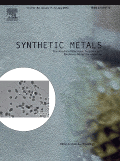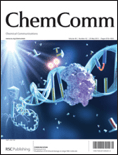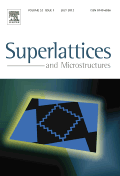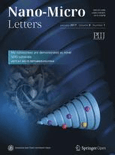
SYNTHETIC METALS
Scope & Guideline
Exploring New Frontiers in Metallic Materials.
Introduction
Aims and Scopes
- Conducting Polymers and Their Composites:
The journal focuses on the synthesis, characterization, and application of conducting polymers, such as polyaniline and PEDOT, and their composites, which are crucial for a range of applications including sensors, supercapacitors, and organic electronics. - Nanomaterials and Nanocomposites:
Research on nanostructured materials, including carbon nanotubes, graphene, and their composites, is a core area, emphasizing their use in enhancing the properties of polymers for electronics, energy storage, and electromagnetic interference shielding. - Electrochemical Applications:
The journal highlights studies related to electrochemical sensors, energy storage devices (such as batteries and supercapacitors), and electrocatalysis, showcasing novel materials and their performance in various electrochemical applications. - Optoelectronic Devices:
Research on organic light-emitting diodes (OLEDs), organic solar cells, and photodetectors is prevalent, focusing on the development of new materials that improve device efficiency and stability. - Environmental Applications:
The journal publishes work on materials designed for environmental applications, including photocatalysis for pollutant degradation and sensors for detecting hazardous substances, highlighting the role of synthetic materials in addressing environmental challenges.
Trending and Emerging
- Hybrid and Multifunctional Materials:
There is a rising interest in hybrid materials that combine different functionalities, such as conductive polymers with nanostructured materials, for applications in energy storage, sensing, and electronics. - Sustainable and Green Synthesis Methods:
Research focusing on eco-friendly synthesis methods for materials, particularly using renewable resources and green chemistry principles, is becoming increasingly prominent, reflecting a broader trend towards sustainability in materials science. - Advanced Characterization Techniques:
The use of advanced characterization techniques, such as in-situ spectroscopy and microscopy, is trending, enabling researchers to gain deeper insights into the properties and behaviors of materials at the nanoscale. - Integration of Machine Learning:
The application of machine learning and computational methods in the design and optimization of materials is emerging, allowing for more efficient exploration of material properties and performance. - Smart Materials and Sensors:
There is a growing focus on the development of smart materials capable of responding to environmental stimuli, which are increasingly being integrated into sensors and actuators for various applications.
Declining or Waning
- Traditional Metal-Based Conductors:
There is a noticeable decline in research centered around traditional metal conductors as the focus shifts towards more innovative and efficient materials like conducting polymers and nanocomposites. - Low-Performance Organic Materials:
Research on low-performance organic materials for electronic applications has decreased, with a stronger emphasis now on high-performance materials that exhibit superior electrical and optical properties. - Single-Function Materials:
The trend is moving away from single-function materials to multifunctional materials that can serve multiple roles, such as energy storage and sensing, indicating a shift in research priorities towards more versatile systems.
Similar Journals

CHEMICAL COMMUNICATIONS
Illuminating the pathways of chemical innovation.Chemical Communications, published by the esteemed Royal Society of Chemistry, is a prominent journal within the field of chemical science, focusing on the dissemination of cutting-edge research in a variety of sub-disciplines including catalysis, materials chemistry, and electronic materials. Operating without an open access model, this journal provides critical insights from contributors around the globe, enhancing our understanding of complex chemical interactions and innovative applications. Ranked in the top quartile for several categories such as Ceramics and Composites, and Metals and Alloys, Chemical Communications boasts impressive Scopus rankings, securing strong positions across multiple fields and showcasing its influence within the scientific community. The journal is committed to advancing knowledge and fostering collaboration among researchers, professionals, and students, making it an invaluable resource for those looking to stay abreast of the latest advancements in chemistry and materials science. With a publication history dating back to 1965 and continuing into 2024, its rich archive serves as a vital repository of chemical research and development.

InfoMat
Unlocking the Potential of Materials Through Accessible ResearchInfoMat is a premier open-access journal published by WILEY that serves as a vital resource for scholars and practitioners in the fields of materials science, materials chemistry, and related disciplines. Since its inception in 2019, this journal has rapidly ascended in academic stature, currently holding a prestigious Q1 ranking across multiple categories, including Electronic, Optical and Magnetic Materials, Materials Chemistry, and Surfaces, Coatings and Films, showcasing its significant impact and relevance. With a commendable impact factor and a comprehensive scope, InfoMat provides a platform for high-quality research that drives innovation in the materials domain, appealing to researchers, professionals, and students alike. The journal’s open-access model enhances visibility and accessibility of cutting-edge studies, fostering a collaborative and informed scientific community. Based in the United Kingdom, InfoMat continues to shape the future of materials research through its commitment to excellence and accessibility.

Journal of Nanoelectronics and Optoelectronics
Innovating Tomorrow's Technologies TodayJournal of Nanoelectronics and Optoelectronics is a premier peer-reviewed journal published by AMER SCIENTIFIC PUBLISHERS that showcases cutting-edge research in the fields of electrical engineering, nanoelectronics, and optoelectronic materials. Established in 2006 and spanning through to 2017, this journal provides a platform for scientists and engineers to share their latest findings, developments, and innovations. Although coverage has been discontinued in Scopus, it retains an regional impact within its field, ranking #388 out of 654 in Electrical and Electronic Engineering and #156 out of 219 in Electronic, Optical, and Magnetic Materials. The journal is crucial for those seeking to advance their knowledge in nanoscale electronic components and optoelectronic devices, making it an essential resource for researchers, professionals, and students committed to this dynamic area of study. While the journal is not open access, it remains a significant contributor to the scholarly discourse surrounding next-generation electronic technologies and materials.

Nature Synthesis
Empowering Researchers to Shape the Future of ChemistryNature Synthesis, published by SpringerNature, is a premier peer-reviewed journal dedicated to advancing the field of synthesis in chemistry and materials science. With an impressive impact factor and categorized in the Q1 quartile for Chemistry (miscellaneous), Inorganic Chemistry, Materials Chemistry, and Organic Chemistry, it ranks prominently among its peers, reflecting its high-quality research output and relevance.
This journal provides a platform for researchers, professionals, and students to publish innovative synthesis methodologies, novel materials, and interdisciplinary approaches that push the boundaries of chemistry. Operating under an Open Access model, it ensures that research is widely accessible, fostering collaboration and engagement across the global scientific community.
Situated in the United Kingdom, Nature Synthesis is committed to contributing to the scientific discourse from 2022 to 2024, and beyond, as it continues to highlight significant advancements across chemistry domains.

RARE METALS
Driving Discovery in the World of Rare MetalsRARE METALS is a prestigious journal at the forefront of materials science, dedicated to advancing the understanding of metallic materials and their applications. Published by the Nonferrous Metals Society of China, this journal has established itself as a leading platform for cutting-edge research in areas including condensed matter physics, materials chemistry, metals and alloys, and physical and theoretical chemistry. With an impressive impact factor and consistently ranked within the Q1 quartile across multiple categories, RARE METALS ranks highly on Scopus, illustrating its significant contribution to the field—such as a remarkable rank of 11/176 in Materials Science for Metals and Alloys and 23/434 in Condensed Matter Physics. Although it operates under a subscription model, its rigorous peer-review process ensures that only the most impactful research is published, making it an essential resource for researchers, professionals, and students engaged in material innovation. Join the global network of materials science by contributing to or exploring the wealth of knowledge RARE METALS offers, fostering advancements in areas vital for technological progress and industrial applications.

SUPERLATTICES AND MICROSTRUCTURES
Innovating through cutting-edge research in condensed matter physics.SUPERLATTICES AND MICROSTRUCTURES is a premier journal dedicated to the exploration and dissemination of cutting-edge research in the fields of Condensed Matter Physics, Electrical and Electronic Engineering, and Materials Science. Published by Academic Press Ltd - Elsevier Science Ltd, this journal has established itself as an important platform for scholars and industry professionals to share their findings related to the design, fabrication, and application of superlattices and microstructured materials. With a commendable impact factor reflected in its rankings—positioned within the top quartile in Physics and Astronomy as well as Electrical and Electronic Engineering—it offers high visibility and influence in the academic community. The journal has covered significant contributions from 1985 to 2022, although access options have transitioned, making staying current essential for researchers and practitioners alike. This journal not only serves as a repository of knowledge but also fosters collaboration and innovation in materials science and related disciplines.

Materials Chemistry Frontiers
Advancing Innovations in Materials ChemistryMaterials Chemistry Frontiers, published by the esteemed Royal Society of Chemistry, stands as a leading journal in the realm of materials science and chemistry, with an impressive Q1 ranking in both Materials Chemistry and Materials Science categories as of 2023. This open-access journal, operating from the United Kingdom, offers a platform for researchers, professionals, and students to disseminate high-quality, impactful research. With its E-ISSN 2052-1537, the journal is dedicated to publishing cutting-edge articles, reviews, and research communications that explore innovative materials and their applications, fostering a comprehensive understanding of the complex interplay between materials and their chemical properties. With consistent rankings in the Scopus metrics, being positioned at the 25th percentile among 317 in the Materials Chemistry category, it highlights its pivotal role in advancing the field. The journal thrives on contributions that broaden the scope of knowledge from 2017 to 2024 and beyond, solidifying its status as an essential resource for contemporary research in materials science.

Nano-Micro Letters
Advancing nanotechnology through open collaboration.Nano-Micro Letters is a premier open-access journal published by Shanghai Jiao Tong University Press, specializing in groundbreaking research in the fields of Electrical and Electronic Engineering, Nanoscience, and Materials Science. Launched in 2009, this journal has rapidly established its reputation, achieving Q1 ranking across various categories, including Electronic, Optical and Magnetic Materials, and Surfaces, Coatings and Films, indicating its significant impact within the academic community. With an impressive Scopus ranking of #5 out of 797 in Electrical and Electronic Engineering and #2 in Surfaces, Coatings and Films, Nano-Micro Letters serves as a vital platform for disseminating cutting-edge insights and innovations in nanotechnology. Researchers, professionals, and students are encouraged to engage with the open-access content, fostering a collaborative environment that promotes the advancement of knowledge in these dynamic fields.

EnergyChem
Elevating Knowledge in Energy Conversion and Storage.EnergyChem is a premier academic journal published by ELSEVIER, dedicated to advancing the field of energy chemistry and its applications in sustainable technologies. With a strong focus on biomaterials and innovative chemistry solutions, the journal has established itself as a leading platform within the research community, boasting remarkable rankings such as Q1 in Biomaterials, Chemistry (miscellaneous), and Energy (miscellaneous) for 2023. Notably, it ranks 2nd in both Materials Science and Energy categories, reflecting the high caliber of research it publishes, which is crucial for tackling pressing global energy challenges. Since its inception in 2019, EnergyChem has been committed to open and accessible research, making it an invaluable resource for researchers, professionals, and students striving for cutting-edge insights in energy conversion and storage. With its target audience in mind, the journal encourages submissions that explore innovative materials, processes, and applications that will contribute to a sustainable energy future.

Journal of Nanostructures
Advancing the Frontiers of NanotechnologyJournal of Nanostructures, published by UNIV KASHAN PRESS, is an esteemed open-access journal that has been actively disseminating groundbreaking research since 2011. With an ISSN of 2251-7871 and an E-ISSN of 2251-788X, this journal has established itself as a significant platform for the exploration of nanostructured materials across various disciplines, including biomaterials, electronic, optical, and magnetic materials. As a testament to its scholarly impact, the journal has achieved notable rankings in its respective categories, including Q3 status in prominent areas such as Mechanics of Materials and Polymers and Plastics. This makes the Journal of Nanostructures a vital resource for researchers and professionals seeking to advance their understanding and innovation in nanotechnology. Furthermore, the journal's commitment to open accessibility ensures that valuable knowledge reaches a diverse audience, facilitating collaboration and growth in this dynamic field. For researchers eager to contribute, the journal offers a platform to publish impactful findings that can influence both academia and industry.